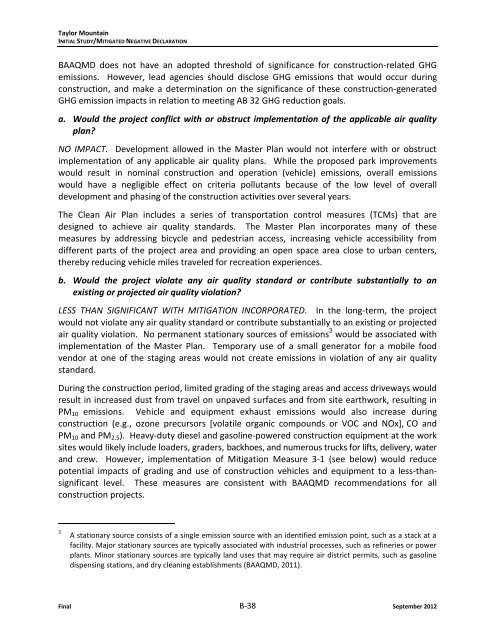Initial Study MND - Sonoma County Agricultural Preservation and ...
Initial Study MND - Sonoma County Agricultural Preservation and ...
Initial Study MND - Sonoma County Agricultural Preservation and ...
You also want an ePaper? Increase the reach of your titles
YUMPU automatically turns print PDFs into web optimized ePapers that Google loves.
Taylor MountainINITIAL STUDY/MITIGATED NEGATIVE DECLARATIONBAAQMD does not have an adopted threshold of significance for construction-related GHGemissions. However, lead agencies should disclose GHG emissions that would occur duringconstruction, <strong>and</strong> make a determination on the significance of these construction-generatedGHG emission impacts in relation to meeting AB 32 GHG reduction goals.a. Would the project conflict with or obstruct implementation of the applicable air qualityplan?NO IMPACT. Development allowed in the Master Plan would not interfere with or obstructimplementation of any applicable air quality plans. While the proposed park improvementswould result in nominal construction <strong>and</strong> operation (vehicle) emissions, overall emissionswould have a negligible effect on criteria pollutants because of the low level of overalldevelopment <strong>and</strong> phasing of the construction activities over several years.The Clean Air Plan includes a series of transportation control measures (TCMs) that aredesigned to achieve air quality st<strong>and</strong>ards. The Master Plan incorporates many of thesemeasures by addressing bicycle <strong>and</strong> pedestrian access, increasing vehicle accessibility fromdifferent parts of the project area <strong>and</strong> providing an open space area close to urban centers,thereby reducing vehicle miles traveled for recreation experiences.b. Would the project violate any air quality st<strong>and</strong>ard or contribute substantially to anexisting or projected air quality violation?LESS THAN SIGNIFICANT WITH MITIGATION INCORPORATED. In the long-term, the projectwould not violate any air quality st<strong>and</strong>ard or contribute substantially to an existing or projectedair quality violation. No permanent stationary sources of emissions 3 would be associated withimplementation of the Master Plan. Temporary use of a small generator for a mobile foodvendor at one of the staging areas would not create emissions in violation of any air qualityst<strong>and</strong>ard.During the construction period, limited grading of the staging areas <strong>and</strong> access driveways wouldresult in increased dust from travel on unpaved surfaces <strong>and</strong> from site earthwork, resulting inPM 10 emissions. Vehicle <strong>and</strong> equipment exhaust emissions would also increase duringconstruction (e.g., ozone precursors [volatile organic compounds or VOC <strong>and</strong> NOx], CO <strong>and</strong>PM 10 <strong>and</strong> PM 2.5 ). Heavy-duty diesel <strong>and</strong> gasoline-powered construction equipment at the worksites would likely include loaders, graders, backhoes, <strong>and</strong> numerous trucks for lifts, delivery, water<strong>and</strong> crew. However, implementation of Mitigation Measure 3-1 (see below) would reducepotential impacts of grading <strong>and</strong> use of construction vehicles <strong>and</strong> equipment to a less-thansignificantlevel. These measures are consistent with BAAQMD recommendations for allconstruction projects.3A stationary source consists of a single emission source with an identified emission point, such as a stack at afacility. Major stationary sources are typically associated with industrial processes, such as refineries or powerplants. Minor stationary sources are typically l<strong>and</strong> uses that may require air district permits, such as gasolinedispensing stations, <strong>and</strong> dry cleaning establishments (BAAQMD, 2011).Final B-38 September 2012







